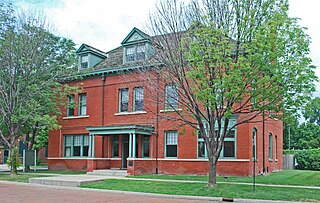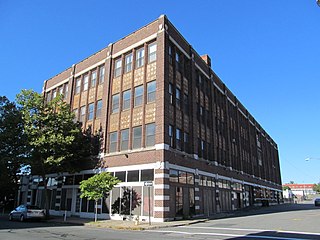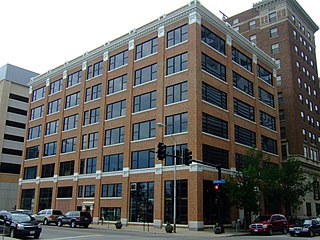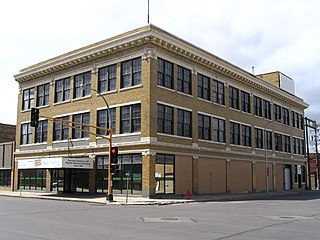
The Burlington Headquarters Building, also called Burlington Place, is located at 1004 Farnam Street in Downtown Omaha, Nebraska. This four-story brick building was originally designed by Alfred R. Dufrene and built in 1879 next to Jobbers Canyon. It was redesigned by noted Omaha architect Thomas R. Kimball in 1899, and vacated by the railroad in 1966. The building was listed on the National Register of Historic Places in 1974, designated an Omaha Landmark in 1978, and rehabilitated in 1983. Today it is office space.

The Durant-Dort Carriage Company Office is a National Historic Landmark owned by General Motors. A late 19th-century office building located at 316 West Water Street in Flint, Michigan, it was built and occupied by GM's parent, Durant-Dort, followed by Dort Motor Car Company, until 1924.

The Stuber–Stone Building is located at 4221–4229 Cass Avenue in Detroit, Michigan. It was listed on the National Register of Historic Places in 1996. It is now known as the Stuberstone Lofts.

The Willys–Overland Block is a historic commercial and industrial block at 151-157 Chestnut and 10-20 Winter Streets in downtown Springfield, Massachusetts. Built in 1916, it is a surviving reminder of Springfield early history in the manufacture and sale of automobile, housing the sales showroom and service center for the Willys–Overland Company. It was listed on the National Register of Historic Places on February 24, 1983.

The Smith Carriage Company District encompasses three buildings on Park Street, Springfield, Massachusetts, between Main and Willow Streets. The buildings, located at 12, 14–38, and 11–31 Park Street, are noted for their historic association with the locally important Smith Carriage Company, a major manufacturer of carriages in the 19th century. The district was added to the National Register of Historic Places in 1983.
Preston J. Bradshaw (1884–1952) was one of the most eminent architects of St. Louis, Missouri, during the 1920s. Among his numerous commissions as an architect, he is best known for designing hotels and automobile dealerships in the region. Like many hotel architects of his time, he eventually moved into the actual operation of hotels, becoming owner and operator of the Coronado Hotel in St. Louis.

The Turner-Todd Motor Company Building, more commonly known as the Buick Building, is a historic commercial building in Mobile, Alabama, United States. The two-story brick and concrete structure was built in 1926 to house the Turner-Todd Motor Company. It was placed on the National Register of Historic Places on May 29, 2008.

The Willys–Overland Building is a former automobile dealership and distribution building for the Willys-Overland Company in St. Louis, Missouri located at 2300 Locust Street. The building was the home of the company's main dealership and distributor in St. Louis from its completion in February 1917 until 1932, and upon its opening, it hosted the first indoor St. Louis Auto Show.

The Clemens Automobile Company Building is a historic building located in downtown Des Moines, Iowa, United States. It was completed in 1916 as an "automotive department store" operated by the Clemens Automobile Company. They sold cars here that were produced by Willys-Overland Motors from 1916 to 1923. There was a claim that this was the largest building in the city that was devoted to automobiles. The first floor was used for the main sales room and offices, the second floor was used for used car sales and the service department, the fourth floor was used for a paint department, and the remaining three floors and the basement were used for storage. The Clemens family was involved in a variety of business enterprises and another one of their companies, the Standard Glass and Paint Company, was housed here from 1924 to 1979. The building was part of the Hotel Fort Des Moines until 2016, the two buildings were linked across the alley in 1985. The first and second floors housed Raccoon River Brewing Co. from May 1997 to March 2015. The building underwent a renovation in 2015 when it was converted to 44 apartments. At that time, the connection to the Hotel Fort Des Moines was sealed off. The first floor has been home to southern restaurant Bubba https://bubbadsm.com/ since July 2016.

The Herring Motor Car Company Building, now known as 10th Street Lofts, is a historic building located in downtown Des Moines, Iowa. The building is a six-story brick structure rising 90 feet (27 m) tall. It was designed by the Des Moines architectural firm of Proudfoot, Bird & Rawson in the Classical Revival style. Clyde L. Herring had the building built in 1912 and it was completed the following year. It was originally a four-story building with two more floors added 18 months after it was originally built. By 1915, the company was building 32 Ford automobiles a day, and had delivered “more automobiles than any other one automobile agency in the United States.” Along with the neighboring Standard Glass and Paint Company Building, today it is part of the same loft apartment complex. The National Biscuit Company Building on the other side of the building has likewise been converted into an apartment building. It was listed on the National Register of Historic Places in 2004.

The Pence Automobile Company Warehouse, also known as Richtman's Printing, is a historic commercial building located on Northern Pacific Avenue in Fargo, North Dakota. It was designed in 1918 by Minneapolis architects Long, Lamoreaux & Long in Classical Revival architecture. The building was completed in 1920 at a cost of more than $175,000. It was listed on the National Register of Historic Places in 1994.

The Illinois Traction Building, located at 41 E. University Ave. in Champaign, Illinois, was the headquarters of the Illinois Traction System, an interurban railroad serving Central Illinois. Built in 1913, the building held the railway's offices and served as the Champaign interurban station until 1936; it later housed the offices of the Illinois Power Company, which descended from the Illinois Traction System. Architect Joseph Royer planned the building in a contemporary commercial design. The building was added to the National Register of Historic Places on September 20, 2006.
The Hotel Hurst Garage, also known as the Roberts Garage, was a historic building located in Maquoketa, Iowa, United States. It was built in 1910 by the owner of the Hotel Hurst next door. The owner of the Decker House Hotel had built a similar building two years earlier. The Hurst sold Buicks and the Decker sold Cadillacs. The cars could serve the needs of the hotels' guests, and it provided an automobile rental service as well as automobile sales. It was a single-story brick structure that featured a tri-partite design. The central garage door was flanked by two display windows that showed off the new cars. The decorative elements were reserved to the top of the building, and included a broad brick paneled frieze, brick corbelled cornice, and a metal cornice. The building was listed on the National Register of Historic Places in 1989. It has subsequently been torn down.

The Hughes-Irons Motor Company is a historic building located in Council Bluffs, Iowa, United States. Floyd Hughes and George Irons established an automobile sales and service business selling Ford cars and tractors. They built the eastern six bay section of this building in 1917. The two-story brick structure exhibits elements of the Mission Revival style. Irons left the partnership three years later and was replaced by Parmer. Hughes-Parmer added the four western bays in 1923, before the business split into two different companies. Parmer maintained the Ford dealership in the original building and Hughes opened a Chevrolet dealership in the addition. Parmer was replaced by the Atlantic Auto Company in 1930. They were the first in a long line of automobile repair shops and dealerships that occupied the original section of the building. Hughes remained in the addition until 1979, although they expanded into the neighboring building to the west in 1944. Restoration of the building began in 2008, reversing the alterations done to its main facade. The local chamber of commerce occupies the main floor, and the second floor was converted into apartments. J. Chris Jensen was the architect, and the building was listed on the National Register of Historic Places in 2011.

The Overland Waterloo Company Building is a historic building located in Waterloo, Iowa, United States. Built in 1916 by the Corn Belt Auto Company, the four-story, brick structure housed the Northeast Iowa distributorship for Willys-Overland Motors. Designed by Waterloo architect Clinton P. Shockley, it features brick and terra cotta pilasters, terra cotta plaques with swag motif, molding, and a balconet. The first floor housed the sales offices and a service garage. The second floor was occupied by a clubroom/lounge, a display room for used cars, a battery-charging room, a workroom, stockroom, shop and employees' room. The third and fourth floors were used to store automobiles to be delivered to dealers and customers. Corn Belt lost their distributorship by way of a corporate restructuring in 1921, but maintained an Overland dealership here until 1927 when they moved to a different building. The building housed other automobile related business until 1955. In that year KWWL radio and KWWL-TV moved into the main floor and other businesses occupied the other floors. Black Hawk Broadcasting Company, which owned the stations, converted the entire building for use as a broadcast facility in 1965. The building continues to function for that purpose. It was listed on the National Register of Historic Places in 2014.

The Motor Mart Building, also known as the Commerce Building, is a historic building located in Sioux City, Iowa, United States. It was built by Ralph A. Bennett, who was the owner of Bennett Auto Supply Company. The structure was designed in the style of the Chicago school by E.J. Henriques of the C.F. Lytle Company of Sioux City, who also built the structure. It was initially designed to be two stories tall, but the plans were changed and two more floors were added. It was designed to display, repair and provide parking for automobiles. It was also the first building in Sioux City to incorporate the flat slab system of framing of Claude A.P. Turner, and it was one of the first reinforced, poured concrete buildings in the city. The exterior of the concrete frame structure is clad with glazed brick over common brick infill. The building features terra cotta decorative elements.

The Maxwell-Briscoe Automobile Company Showroom is a historic automobile showroom located at 1737 S. Michigan Avenue in Chicago's Motor Row District. The showroom was built in 1909 for the Maxwell-Briscoe Motor Company, which was founded in 1904 by Jonathan D. Maxwell and Benjamin Briscoe. William Ernest Walker, a Chicago architect who specialized in large-scale commercial buildings, designed the showroom. The four-story building is divided by brick piers; the ground floor features large plate-glass windows designed to showcase the company's automobiles, while the upper floors feature banks of double-hung and triple-hung windows between the piers. The building uses terra cotta extensively for decoration; a terra cotta stringcourse encircles the building above the first floor, terra cotta pediments and sills frame the window banks, and a terra cotta frieze runs below the roof line. Maxwell and Briscoe used the building as a showroom until 1915; it is one of the oldest surviving auto showrooms on Motor Row.

The Vesper-Buick Auto Company Building, at 3900-3912 W. Pine in St. Louis, Missouri, was built in 1927. It was listed on the National Register of Historic Places in 1986.

The William A. Paterson Factory Complex was a factory located at 126 East 3rd Street in Flint, Michigan. It was listed on the National Register of Historic Places in 1984. The building was demolished in 1996.

The Checker Cab Building was built as a garage and office building located at 2128 Trumbull Avenue in Detroit, Michigan. It was listed on the National Register of Historic Places in 2019. The building has been rehabilitated into residences, and is now part of the Elton Park lofts.




















